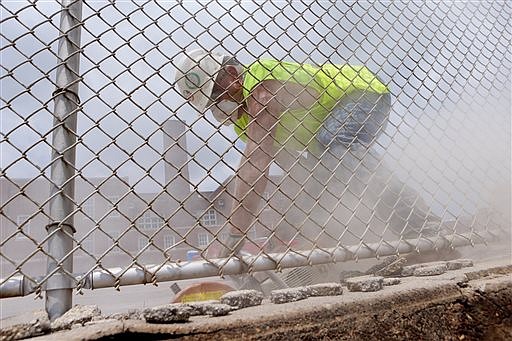ST. LOUIS (AP) - It's been more difficult than it should be for Joe Weis to teach physical education at Nahed Chapman New American Academy.
Not only did he alone teach PE at the school of 400 refugee and immigrant children this year, but the school's outdoor play area also looks like a dried riverbed. Its aged asphalt is laced with webs of cracks. The sun-bleached, gray ground is uneven and full of valleys, hills and gaping pits of gravel and dirt.
Three years ago, a high school student tripped on the playground and was taken to the hospital. Since then, there haven't been any injuries.
"We've been blessed," Principal Donnie Harris said.
A collection of people and groups in St. Louis are seeing to it that an artificial turf field gets built at Nahed Chapman this summer, for free.
St. Louis Public Schools has lacked money to build, maintain or renovate a simple school field for years, officials say.
The district at best has a "very slim maintenance and repair budget," said Mary Houlihan, director of operations for the district.
"It really is that that field was not going to happen without this," Houlihan said of the community effort.
Nahed Chapman, a complex in the 1500 block of South Grand Boulevard, is where refugee and immigrant children come to learn English and receive an American education - or, for many, any education - for the first time.
The St. Louis Post-Dispatch (http://bit.ly/29CMe4y ) reports that many of their parents or relatives were killed in war or violence-ridden nations. Many of the students came to the U.S. alone. Many of them came here only to find that the people who were supposed to take them in were nowhere to be found.
Harris estimates that about 70 percent of her students, who come from 41 countries, have been through severe trauma, stress or depression. Therapy is common at the school, and Harris is starting a "trauma-informed curriculum" in the coming school year.
Any chance for the students to get outside, play sports and forget about some of that stress, such as on this newfield, brings Harris close to tears.
"Oh my god, the kids, the field . I may start crying talking about this," Harris said. "It would not be the answer to everything, but it would definitely be a big help to our students to be able to walk the field, to get outside."
For years, the school, which offers kindergarten through 10th-grade classes, has had only enough money to employ one teacher per grade, even though enrollment has doubled from 200 students in 2009 to 400 this past school year, Harris said. Next year, officials expect to have 500 as St. Louis takes in more refugee families.
Meanwhile, the school's library received its first books with a donation this year. There's no money yet for after-school programs or athletics.
With this new turf, students will get to play a real game of soccer on a real field - not one where they have to dodge coned-off pits of gravel to avoid getting hurt.
Weis and Harris are excited about having soccer for the students because it's perhaps the one sport everybody knows how to play.
"Every kid, no matter what country they come from, they know soccer," Harris said.
Peter Tao, an architect, started a coalition of people and groups for this soccer project. The so-called Gateway Welcome Project includes the St. Louis Scott Gallagher Soccer Club, which has already offered clinics and outings for Nahed Chapman students; the St. Louis Mosaic Project; and Washington University.
The field is only part of the larger project, which is focused on making St. Louis newcomers feel more welcome.
"Changing St. Louis demands an inclusive society and a welcoming place," said Tom Finan of Construction Forum St. Louis, another partner in the Gateway Welcome Project. "It's not just the right thing to do. It's the future of what any city that aspires to be anything needs to look like."
PHL Inc. is the nonprofit that's actually building the field. It has been building and maintaining athletic fields for city public schools since 2006. Thom Kuhn, PHL's director, said this would be the 11th one PHL has built in St. Louis.
"Somebody called and said it needed to be done," Kuhn said. "We've been doing it for so long, it seemed like the thing to do."

